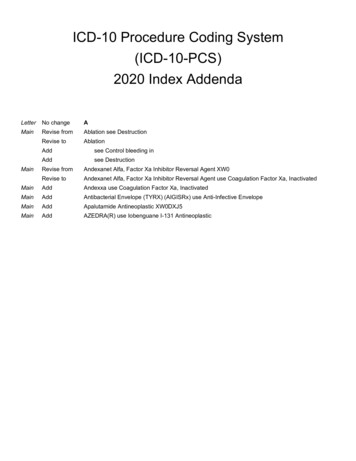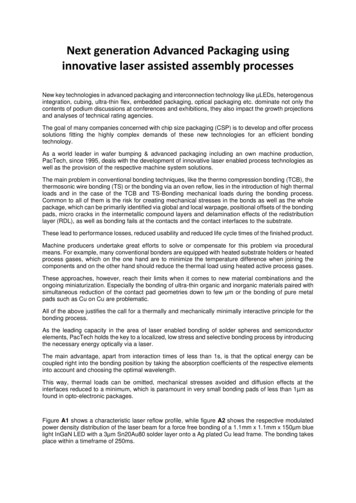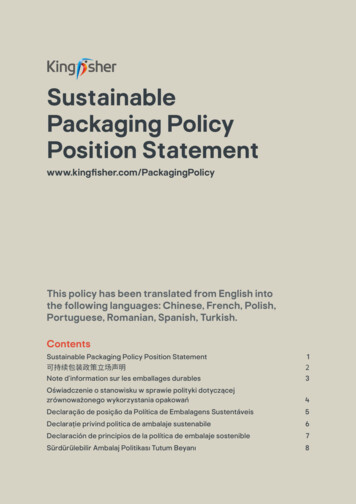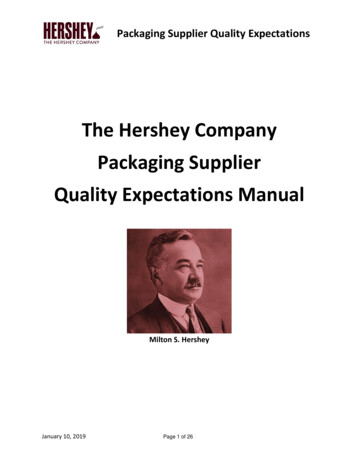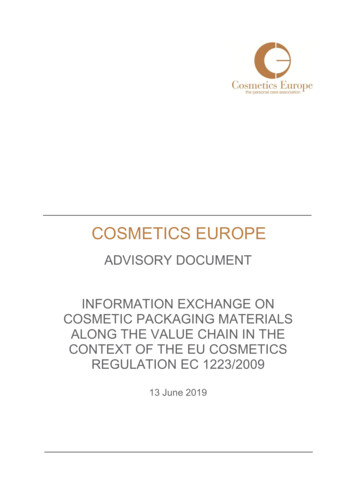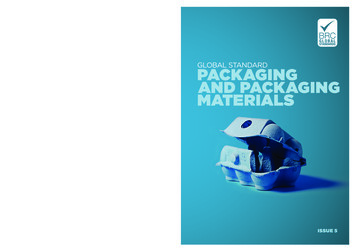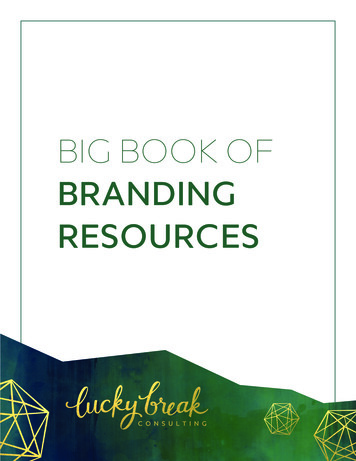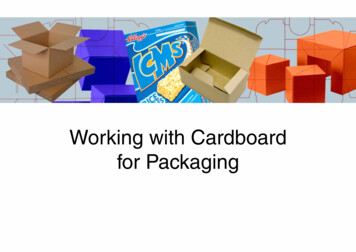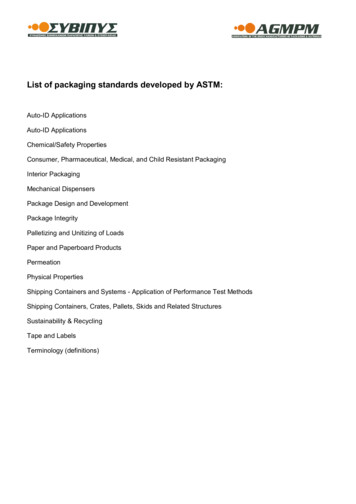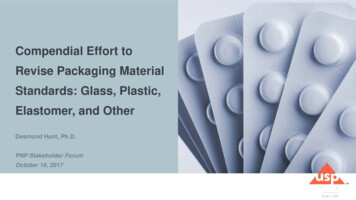
Transcription
Compendial Effort toRevise Packaging MaterialStandards: Glass, Plastic,Elastomer, and OtherDesmond Hunt, Ph.D.PNP Stakeholder ForumOctober 19, 20171 2017 USP
USP current efforts in revision of packaging standards Plastic Plastic Materials of Construction - 661.1 Plastic Packaging System for Pharmaceutical Use - 661.2 Plastic Component and Systems Used in the Manufacturing of a Drug Product - 665 Elastomeric components used for pharmaceutical use Injectable Drug Products - 381 Functionality Testing - 382 Glass Containers Used for Pharmaceutical Use - 660 Metal Containers Used for Pharmaceutical Use - 662 Biocompatibility Testing of Plastic and Elastomeric Material Biological Reactivity, In Vitro - 87 Biological Reactivity, In Vivo - 88 Biocompatibility of Materials - 1031 2
A starting point for the revision of USP standards Building safety into a system by using well-characterized and safematerials of construction (Quality by Design). The testing required to select and qualify a packaging system iscorrelated with the risk that the packaging system or component willinteract with the final drug product (Risk-based Approach). The USP standard serves as a baseline Should have value in every situation of use, but may not necessarily addressevery individual situation of use3
Plastic materials and packaging systems 661.1 Plastic Material of Construction IdentificationBiological ActivityPhysico-chemical TestsExtractable MetalsPlastic Additives 661.2 Plastic Packaging Systems forPharmaceutical Use Biological Activity Physico-chemical Tests Safety Assessment(Extractables/Leachables)
661.1 Plastic Materials of ConstructionTest ParameterOral and Topical Dosage FormsAll Other Dosage FormsChemical TestsIdentificationDSC/IRDSC/IRPhysicochemical TestsWater extraction: UV absorbance, Acidity/alkalinity TOCAcid extraction: ICP analysis for targeted and relevantmetalsProper Reference to Indirect Food AdditiveRegulations, CFR 174-186Water extraction: UV absorbance, Acidity/alkalinity TOCAcid extraction: ICP analysis for targeted and relevantmetalsDirect chemical testingExtractable MetalsPolymer AdditivesBiological ReactivityIn Vitro per USP 87 RequiredRequiredIn Vivo per USP 88 Not requiredRequired as needed to obtain plasticclassification
661.1 Material Characterization Chapter Objective: gain as much information about a material ofconstruction to determine potential suitability Requirements of 661.1 can be met by: The materials of construction meeting requirements of 661.1 The component or system meeting the requirements of 661.2 6
661.2 Plastic Packaging Systems for Pharmaceutical UseComparison of Testing Required for Various Dosage FormsTest ParameterOral and Topical Dosage FormsAll Other Dosage FormsChemical TestsPhysicochemical TestsWater extraction: UV absorbance, acidity/alkalinity TOCWater extraction: UV absorbance, acidity/alkalinity TOCChemical Assessment—Extractables and LeachablesRisk-based testing*Risk-based testing*Biological ReactivityIn Vitro per USP 87 In Vivo per USP 88 RequiredNot requiredRequiredRequired as needed to obtain plasticclassification7
661.1 and 661.2 Sample commentsBiological Reactivity TestingComment/Concern: Biological reactivity testing for SODF does not seem tobe appropriate for the level of risk.USP Position: A cornerstone of suitability for use assessment of packagingsystems and their materials of construction is the concept of orthogonalassessment. Individual means of assessment are generally insufficientlyrobust or broad in scope to provide rigorous and complete assessments ontheir own, thus orthogonal assessments are preformed to essentially “fill thegaps” in the individual assessments.PF 42 (4) July 2016: Proposed the removal of the Biological reactivitytesting for SODF and Topical Dosage Forms
661.1 and 661.2 Sample comments (cont’ed)TOC and Absorbance TestingComment: Materials that would not pass the test that could still be usedfor certain applicationsPlanned Revision:“If the specification for absorbance or TOC is exceeded, then the materialor packaging system can still be deemed acceptable if the chemicalsresponsible for the test results can be established (identity andconcentration) and the chemicals are safety assessed to establish that theprobable safety risk posed by all the chemicals, considered individually, iswithin acceptable parameters.”
661.1 CommentsExtractable Metal Testing Comments: Some of the metals specified in 661.1 arefundamentally misaligned to 232 Metal specifications in the chapter are not based no clearbasis from either a toxicological or quality perspective andshould be removed 661.1 should directly reference 232 because thechapter already discusses the contributions of packagingcomponents to the final drug product.
661.1 Comments The concept of relevant elements– a relevant element is one which is a known constituentof the material or component that could potentially arisefrom a starting material, additive, or manufacturingprocess and elements of known toxicological concernas outlined in 232 .– Nontoxic elements that are intentionally added becauseof potential drug product sensitivities and interactions
661.1 CommentsExtractable Metal Testing Comments: Metals specified in 661.1 are fundamentally misaligned to 232 Metal specifications in the chapter are not based on either atoxicological or quality perspectivePOLYVINYL CHLORIDE, PLASTICIZEDArsenic, cadmium, lead, mercury, cobalt, nickel, and vanadium: Report themeasured value in Solution S3 at values above 0.01 mg/L (ppm), corresponding to0.025 mg/g. If the measured values are below these values, report the result as lessthan 0.01 mg/L (ppm), corresponding to less than 0.025 mg/g. Barium: S3 contains NMT 0.25 mg/L (ppm), corresponding to 5 mg/g.Calcium: S3 contains NMT 35 mg/L (ppm), corresponding to 0.07 weight %.Tin: S3 contains NMT 1 mg/L (ppm), corresponding to 20 mg/g.Zinc: S3 contains NMT 100 mg/L (ppm), corresponding to 0.2 weight %.
661.1 CommentsExtractable Metal Testing Comments: 661.1 should directly reference 232 232 already discusses the contributions of packaging components tothe final drug product.USP Position: 232 limits don’t apply to 661.1 The focus has been on the risk assessment option in 232 How to get the necessary data to make a decision regarding the selectionof a material for a new product or for a packaging material change.In the control of plastic materials, extractable metals is an importantattribute to understand and testing seems to be the only way to obtain thenecessary data.
Grandfather: currently approved productsRationaleGoal of 661 revisionTo aid in the selection and qualification of packagingmaterials and components that are deemed suitable and safeSuitability and safety of a packaging system, with its drug product,is determined by regulatory authorities A packaging system, with a specific drug product, would meet therequirements of 661.1 and 661.2 , if it had gained regulatoryapproval.
Removal: Grandfathering exemptionWhy? The standard, as written, states when the chapter is/is not applicable Regulatory discretion One standard for all products is easier to manageHow? Revision Bulletin 661 : USP 38 (2015) version was reintroduced to the chapter, which will be official until May 1, 2020. 661.1 and 661.2 : These chapters will become official on May 1, 2020 . Early adoption of therequirements in these chapters are permitted by USP. When early adoption is not used, 661 willapply and must be met wherever 661.1 or 661.2 are referenced in the USP-NF.
661.1 and 661.2 Revision timelineIntent to Revise: March 31,2017Revision Bulletin: May 1 2017 661 USP 38 Version: Made Official 661.1 and 661.2 : Postponed/Early AdoptionPublished in USP 41 (Nov 2017) Biological Reactivity forSODF/TopicalUSP 41: May 1, 2018 TOC and Absorbance OfficialMay 1 2020
660 Containers – GlassExtractable Tests: Glass Grains Test measures the amount of extracted alkali from glass matrix to determineGlass Type Type I Borosilicate glass Type II Treated soda-lime-silica glass Type III Soda-lime-silica glassInner Surface Test Surface Glass Test measures the amount of extracted alkali from the glassinner surfaceArsenic test measures the amount of extracted arsenic from the glass innersurfaceSpectral Transmission Test: For colored glass containers
Phase I revision for glass containers - 660 PF 43 (3) May 2017 The chapter title has been changed to “Glass Containers Used inPharmaceutical Packaging/Delivery Systems”. A Scope section has been added. Table 1 and Table 2 have been consolidated into one table which contains thespecifications for the Surface Glass Test, Glass Grains Test and Surface EtchingTest for a glass container to be classified as Type I, II, or III. The list of ancillary equipment required to execute the chapter has beenexpanded. The Purified Water requirement has been aligned with the Pharm EuropaGeneral Chapter 3.2.1 "Glass Containers for Pharmaceutical Use".18
Phase I revision for glass containers - 660 PF 43 (3) May 2017 Additional information on the Autoclaving Procedure has been added tothe chapter, including Reference temperature curve, Autoclave calibration,and Routine autoclave runs. Additional requirements for the autoclave used for the various tests havebeen added to the chapter. Additional information on how to titrate the test and blank samples hasbeen added to the chapter.19
Phase II revision for glass containers - 660 Inclusion of other glass composition: How can the standards be revised to include other glass materials, beyond borosilicate and soda-limeglass, that conform to the chapter specifications? Analytical Methods: The titration method for Glass Grains and Inner Surface Tests measures the sum of alkali oxides. Itdoes not quantitate individual elements. Quantify individual extracted alkali elements by inductively coupled plasma optical or atomic emissionspectroscopy (ICP-OES or ICP-AES) The method to determine extractable Arsenic is outdated (colorimetric) Quantify extractable Arsenic by ICP-OES or ICP-AESCan a test be developed to differentiate between internal surface areas, e.g. heel, side wall, neck, intubular containers (ampules, vials)?20
Status 660 Containers-Glass 1660 Evaluation of the Inner Surface Durability of Glass ContainersPublication: PF 43 (3) May 1, 2017Comment Deadline: July 31, 2017 (September 30, 2017)21
Changes for elastomeric closures for injections - 381 Title Changes Elastomeric Components Used in Injectable Pharmaceutical Packaging/Delivery Systems Emphasis on baseline requirements for the selection of thermoset and thermoplasticelastomeric components. Expand the scope to include all elastomeric components used in an injectionpackaging system, included but are not limited to: Those used for vials, bottles, prefilled syringes (plungers, needle shields, and tip caps), cartridges(plungers and seal liners), injection ports for flexible bags and infusion sets, and plungers for singleuse syringes. Deleted the Heavy Metals ⟨231⟩ testing, added new method for extractable elements.Moved functionality tests and assessment to new chaptersDevelop a new informational chapters22
382 Elastomeric Closure Functionality Testing Physicochemical, biological reactivity and extractable elements test in 381 areintended for testing individual components Functional testing can only be done on the whole packaging system. Functionality testing in current 381 is limited to testing closures intended to bepierced by a hypodermic needle for penetrability, fragmentation and self-sealingcapacity. 382 is meant to addresses suitability for intended use (functionality) of thevarious packaging/delivery systems intended for injectable dosage forms Elastomeric Component should work with packaging system to protect and contain packaged contents enable safe and effective product access at the time of use23
382 : Scope Bottle and vial stoppers intended to be accessed with a needleor spike Prefilled syringe or cartridge plungers, needle shields, tip caps Pen, jet or related injector system components Blow-fill-seal plastic container lined caps Plastic bags or blow-molded infusion container access ports24
Status 381 Elastomers Used in Pharmaceutical Packaging/Delivery Systems Elastomeric Components Used in Injectable Drug Product Packaging/DeliverySystems 1381 Evaluation of Elastomeric Components Used in PharmaceuticalPackaging/Delivery Systems 382 Elastomeric Closure Functionality in Injectable PharmaceuticalPackaging/Delivery Systems 1382 Assessment of Elastomeric Closure Functionality in InjectablePharmaceutical Packaging/Delivery SystemsPublication: PF 43 (3) May 1, 2017Comment Deadline: July 31, 2017 (September 30, 2017)25
USP current efforts in revision of packaging standards . Extractables and Leachables . Risk-based testing* Risk-based testing* Biological Reactivity . In Vitro per USP 87 Required . Required : In Vivo per USP 88 Not required . Required as needed to obtain plastic classification

